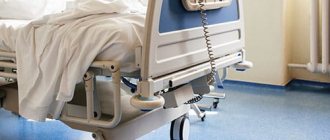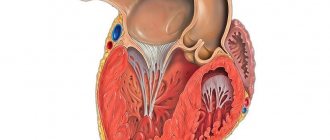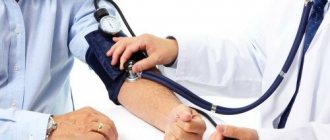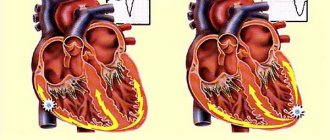Exercising during sports can bring both benefits and harm - it all depends on how you train.
Professional athletes increase the intensity of their training under the guidance of a specialist mentor and taking into account the task at hand. And for lovers of a healthy lifestyle, there is an instructor in the gym, sports gadgets for monitoring heart rate, and mobile applications. But all this is not enough if you do not understand the mechanism of training the heart muscle.
When the heart rate is generally elevated
It is worth remembering that there are categories of people whose heart rate is elevated, regardless of physical activity. “Most often, an increased heart rate occurs in obese people, as well as in people with little exercise who lead a sedentary lifestyle. Also, in young women we observe a slightly higher pulse rate than in men,” says Tatyana Shalygina.
Related article What to eat and drink before sports training?
The cardiologist notes that a heart rate from 60 to 90 is considered normal (previously this parameter was lower, a pulse of 60-80 was considered normal). This is provided that the person does not have any reliably confirmed cardiovascular diseases.
“With age, the requirements for pulse increase, especially if there are diseases of the heart and blood vessels, here we already achieve lower pulse values, including due to medications. But this is mainly in older patients with chronic cardiovascular diseases,” says Tatyana Shalygina.
Heart rate often depends on the autonomic nervous system, notes the cardiologist. First of all, the sympathetic nervous system is responsible for it. “In stressful situations and fatigue, there is an increase in heart rate precisely due to the sympathetic nervous system,” says Tatyana Shalygina.
The pulse can also increase against the background of ARVI as a reaction of intoxication, says the cardiologist. Moreover, this is possible for any virus. “The pulse can increase significantly, sometimes even up to 100-105 beats per minute,” says Tatyana Shalygina.
Those who, during exercise, feel not only palpitations, but also “fluttering” in the chest should be especially careful. If they occur during physical activity, you should consult a doctor, warns the cardiologist.
Everybody go for a run! What sport should I take up in the spring? More details
Degree of disease development
There are various forms of paroxysmal tachycardia, depending on the anomalies in which part of the heart it is caused:
- Ventricular tachycardia - this pathology develops when the patient has defects in the heart muscle. For example, we can talk about scar lesions, tissue sclerosis, atrophic and other disorders. Ventricular tachycardia often occurs after such serious cardiac problems as ischemic disease, myocardial infarction, congenital or acquired defects.
- Supraventricular tachycardia - occurs in most cases against the background of a pathological state of the elements of the patient’s sympathetic nervous system.
Heartbeat in sports
An increase in heart rate during physical activity is generally considered normal, says the cardiologist. “The heart rate reasonably increases when we move and especially when there is active physical activity,” says Tatyana Shalygina.
To prevent problems, you should calculate in advance the optimal values for increased heart rate for physical training and carefully monitor it. “There are certain formulas by which the maximum and submaximal values of heart rate are calculated for a particular patient in accordance with age or gender, as well as weight. These are the parameters that are recommended to be achieved during training,” says Tatyana Shalygina.
Article on the topic
With a health risk. What sports are considered the most dangerous?
There are many such formulas, the cardiologist emphasizes. You can calculate the optimal heart rate for exercise yourself. So, the simplest formula for submaximal values is 200 minus age, for maximum values - 220 minus age. “The only thing is that during exercise we do not recommend reaching the maximum; it is worth working up to 75% of the maximum heart rate,” says the cardiologist.
Therefore, during training, you should constantly monitor your heart rate values and react in time if something goes wrong.
Cardio equipment. Pros and cons
When you get to the gym, you should start working out on cardio equipment. They increase endurance, which means you can exercise more intensely. All cardio equipment is divided into four main types:
- exercise bikes,
- Treadmills,
- steppers,
- elliptical trainers.
Exercise bikes.
These simulators are very popular today. The load in the simplest exercise bikes is created through the use of a belt drive. These devices make virtually no noise; in addition, the pedals rotate without jerking, which has a positive effect on the joints. For people who are overweight or have heart disease, cycling can do more harm than good. In the standard position, their spine is heavily loaded. Recumbent exercise bikes were developed especially for them. Their owners can pedal in a lying or semi-lying position, completely isolating the upper body from the load.
Treadmills.
Treadmills were designed especially for those who want to go for a run without looking up from their favorite TV show. The main part of the device is the canvas. During training, it moves under your feet, representing the road surface. An equally important component of the treadmill is the on-board computer. A special sensor, attached to the exerciser’s body or to the handle of the exercise machine, measures the pulse and transmits the data to the computer. The heart rate can be seen on the screen at any time and, if necessary, the pace can be adjusted to achieve optimal performance, which is very important for cardiovascular diseases. Top models even know how to automatically set the desired running speed. If the heart is ready to burst out of the chest, the computer slows down the overly zealous runner, and if the pulse is too low, it changes the angle of inclination and speed of the belt, forcing the trainee to give his best.
Steppers.
A small platform with two pedals, called a stepper, creates the complete illusion of walking on steps, and the steepness of the stairs can be adjusted using levers or buttons. Today, steppers are the most compact and affordable cardio equipment. Expensive models are equipped with stop railings and full-fledged on-board computers.
Elliptical trainers.
All cardio equipment is good in its own way. But if you want, you can find flaws in all of them. One loads too few muscles, another has a bad effect on the joints, and the third causes pain in the spine. Not long ago, elliptical trainers appeared on the market. The movements performed on this hybrid of a treadmill, stepper and exercise bike have no analogues in nature. The athlete's feet stand on the pedals and move along an oval path. It is this kind of load that not only does not harm the joints, but also maximally trains the most important muscle groups of the lower half of the body. To pump up the arms, back and chest, instead of traditional handrails, the simulator is equipped with movable handles.
Preparing for training.
The time and place of training is selected individually, focusing on a person’s biorhythms. But we must keep in mind that you cannot start training earlier than 2-3 hours after sleep. Evening workouts should be completed 2 hours before bedtime. Do not train under bright sunlight or artificial light (neon, halogen).
Food, drink. Exercises should be carried out 2 hours after eating, and after training, try not to eat for at least an hour.
Clothes for training should be light and allow the body to breathe; shoes – sports shoes, for example, running shoes. Wearing a lot of clothes will cause you to sweat more. Additional weight loss is fluid that will be replenished with the first glass of water you drink.
Warm up . Each workout should begin with a warm-up in order to prepare the body for subsequent work. The warm-up should be light and preferably engage those muscles that will be involved in the work.
Cardio training - basic mistakes
- Long, low-intensity training. Until your heart rate rises to 60-80% of maximum, you will train with minimal efficiency.
- Wrong choice of load in cardio equipment. A quick workout in hopes of burning fat.
- Take a carbohydrate supplement before training. We recommend having a small snack an hour before training. An apple or low-calorie yogurt would be great. These calories are just enough to get to the gym...
Workout on an empty stomach
You shouldn’t torture yourself with a hunger strike - it’s enough not to eat 45-60 minutes before training. This is due to the fact that carbohydrates take up to 1 hour to be absorbed, fats up to 4 hours. Moreover, the body also spends calories on digesting food, but it takes them from those already available, and not from those that have just arrived.
The more you sweat, the more effective the fat burning process.
Often before competitions, athletes run in tight suits in order to lose weight through evaporation and get into the desired weight category. They manage to lose a few kilograms, but after replenishing the fluid deficit, the weight returns to its previous level, so there is no need to chase quick results.
Cardio training compensates for an unhealthy lifestyle
Cardio training prevents you from gaining weight
If your goal in training is to gain muscle mass, don't be afraid of cardio. The heart should be given not only anaerobic exercise, but also aerobic exercise. 1-2 light cardio workouts per week will be just right, especially since they can be combined with strength training.
In the end, let us once again note the truly important components of successful cardio training:
Short but actually intense exercise (interval training)
Really timely prevention of body dehydration
Proper nutrition
Healthy sleep at least 8 hours a day
Medical warnings.
Working out on a cardio machine is a fairly intense physical activity. Even if you are absolutely healthy, listen carefully to yourself during exercise. Pain in the heart area or behind the sternum, a feeling of lack of air, severe shortness of breath, dizziness, nausea, weakness, headache - any sudden deterioration in well-being means that the training needs to be stopped. If you suffer from hypertension with frequent crises, then before you start training, consult your doctor.
Attention! Training is strictly contraindicated in cases of severe cardiovascular insufficiency with attacks of cardiac asthma, edema, as well as thrombophlebitis, tachycardia and frequent attacks of angina. You should avoid training in case of severe forms of diabetes mellitus and cancer that require urgent treatment. You should not exercise if you have any infectious disease.
How to correct the situation?
“If, against the background of physical activity, malaise or rapid heartbeat appears, physical activity should be stopped. But not sharply, but slowly. Be sure to endure a recovery period when the pulse returns to normal. For example, reduce the load a little if this happened on the treadmill, reduce the speed if you can’t tolerate it well and your heart rate has increased significantly,” says Tatyana Shalygina. Yes, the pulse has the right to rise against the background of the load, it will be scary if it does not react to the load and does not increase. But an overly active heartbeat should also be a signal that something is wrong.
Article on the topic
Running from a heart attack. Is it true that sports are good for a diseased heart?
From the point of view of an increase in heart rate and assessing whether this is normal, a person’s fitness also matters. If a person is an athlete, his heart rate will initially be lower, and his pulse will rise more slowly during exercise.
Today, fitness clubs ask for a cardiologist's opinion or a certificate of admission to physical education and sports. You can also get tested at a specialized sports dispensary. This will eliminate contraindications to exercise, the cardiologist notes. “We sometimes ask to undergo a stress test in order to record a cardiogram during exercise and make sure that the person tolerates physical activity well,” says Tatyana Shalygina.
This will allow you to structure your workouts more competently, to know exactly the heart rate values, so that you can correctly monitor it and reduce it in time during the training process.
Class Rules
“Physical exercise needs to be done daily. For those with moderate exercise tolerance and moderate heart failure, moderate-intensity exercise can be prescribed, such as walking for 30 minutes every day. With high tolerance and mild heart failure, you can walk for 1 hour or ski in winter,” says the cardiologist.
At the same time, patients cannot increase the load on their own; they should definitely consult a doctor. So it is quite possible to escape from a heart attack, but only with all precautions and the right approach to training. There is no point in setting Olympic records, but you definitely need to think through an individual training program.
There are contraindications, you should consult your doctor
Training rules
To prevent training from negatively affecting your heart condition, you should follow simple rules. “If you come to a fitness club for the first time, it is reasonable to contact a trainer to choose an adequate physical activity for yourself, taking into account your weight, age, and the presence of chronic diseases. You should also not overdo it in the club, especially in the first lesson. After all, you should understand that this is already stressful for you, and before there was no proper physical activity,” says Tatyana Shalygina.
It is worth strictly remembering the stages and frequency of training. “First of all, the key to the success of training is its regularity, which means 2-3 times a week. In addition, they must be at least an hour in total when you visit a fitness club. This is true even for walking outside, which we often recommend to patients with cardiovascular disorders. We recommend walking for at least an hour, preferably 2 hours. And we recommend taking 6-10 thousand steps a day,” says the cardiologist.
Fashion for health. Bright Soviet posters about sports Read more
In addition, Tatyana Shalygina notes, the stages of training are also important for proper heart function. The first stage is preparation for the load. It takes approximately 10-15 minutes from the workout if we take the workout for an hour. The main stage should be about 30 minutes, when the main load on the body occurs. And, of course, a recovery period is required, when a person gradually reduces the load, including restoring the heartbeat.
“If at any stage, especially in the first days of attending training, any complaints arise in the form of severe shortness of breath, increased palpitations that the patient feels, a feeling of interruptions in the heart’s function, you should slowly stop training and then seek advice from a cardiologist or a therapist,” says Tatyana Shalygina.
Diagnostics
Only a cardiologist can determine how to treat cardiac tachycardia. It is useless to treat tachycardia itself as a symptom. The only effective way to combat heart palpitations is to eliminate its root cause.
- Available: doctor’s appointment from 1500 rubles
- Convenient: open daily from 8:00 to 21:00
- Quickly: we will carry out all the diagnostics at the first appointment
- Complete: has all the necessary equipment
But first of all, the root cause must be correctly identified. For this purpose, experienced cardiologists prescribe comprehensive diagnostics to medical patients. A set of laboratory and hardware examinations may include:
- Electrocardiogram is standard.
- Daily ECG monitoring according to Holter, 2-3 days monitoring).
- General and detailed blood tests.
- Analysis of urine.
- Blood test for thyroid hormones.
- Ultrasound diagnostics of the heart.
- Echocardiography.
Cardio training. Everything you need to know about her
Cardio training is essentially the same as aerobic training. in which the heart, cardiovascular system and respiratory organs receive the main load. The goal of cardio training is to strengthen these organs, burn fat, and develop endurance.
Since the heart is the main organ in the human body, cardio exercise plays a key role in human health. But still, the initial goal of most exercisers is to burn fat. After all, cardio training is the best way to do this.
This article will discuss the basic rules for performing cardio training, and you will also receive advice on how to make cardio training more effective and burn fat much faster.
Permitted species
Running and active sports
With tachycardia, not all sports are allowed, except running.
Sports are not always considered a contraindication for tachycardia. There are certain restrictions, but fixed physical activity, on the contrary, will be useful. For example, running is one of the permitted sports. It should be remembered that it is dangerous for people with heart problems to run fast with tachycardia. It is also not recommended to run a long distance on the first day of classes. A sudden load can cause an attack of tachycardia.
At first, you should start with walking, gradually moving into jogging. Classes should last no more than a quarter of an hour, with the time increasing by a few minutes every day. Subsequent runs last about 30-40 minutes. It is important to monitor blood pressure, pulse and heartbeat, and keep indicators under control.
Active and play sports are not considered prohibited. The most common of them are presented in the table:
| Kind of sport | Benefit for health |
| Volleyball | The muscles of the legs and arms are involved; at the same time, they are tensed and strengthened |
| Tennis (table) | Quiet play brings pleasure and relaxes the nervous system |
| Billiards | Sets a person in a positive mood, improves communication skills, helps eliminate frequent tachycardic attacks |
The benefits of swimming
With a disease such as tachycardia, swimming is a valuable, and most importantly, calm sport. The pool is useful not only for adults, but also for children. Benefits of swimming:
- relaxes;
- allows you to relax and lift your spirits;
- strengthens the muscles of the whole body.
Physical training
As for exercise therapy, there are no restrictions. Specially selected physical therapy exercises have a positive effect on the human body. The exercises can be done at home or you can visit a physical therapist who can show you how to do the exercises to best benefit your body.
Morning exercises will also be no less useful for a person suffering from attacks of tachycardia. It is enough to devote 10-15 minutes of free time in the morning to recharge yourself with vigor and activity for the whole day. It is also better to refuse to travel by public transport and car, and to walk (over short distances). When walking, all types of muscles are involved, they are warmed up and strengthened.










